|
RECORD DISPLAY CONTROL
|
COLLECTION OF THIS PRESIDENT |
|
|
|
|
|
VICE PRESIDENT
Record Details
|
|
|
Name : |
Drs. Mohammad Hatta |
Nickname : |
Bung Hatta |
Gender : |
[Data tidak dicantumkan] |
Place of Birth : |
Kampung Aur Tajungkang, Bukittinggi, Sumatera Barat |
Date of Birth : |
12 Agustus 1902 |
Took Office : |
1945 |
Years of Retirement : |
1956 |
Brief History : |
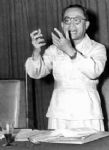 Description of Drs. H. Mohammad Hatta (also known as Bung Hatta, born in Bukittinggi August 12, 1902 - died in Jakarta March 14, 1980) is a warrior, statesman, and also the first Vice-President of Indonesia. He resigned from his position as vice president in 1956, because at odds with President Sukarno. Hatta is known as the father of Indonesian Cooperatives.
Description of Drs. H. Mohammad Hatta (also known as Bung Hatta, born in Bukittinggi August 12, 1902 - died in Jakarta March 14, 1980) is a warrior, statesman, and also the first Vice-President of Indonesia. He resigned from his position as vice president in 1956, because at odds with President Sukarno. Hatta is known as the father of Indonesian Cooperatives.
The name given by their parents at birth is Muhammad Athar. He is buried at Tanah Kusir, Jakarta.
Background and education
Hatta was born from a family scholars Minangkabau, West Sumatra. He was educated at Sekolah Melayu basis, Bukittinggi, and later in the year 1913-1916 to continue her studies to Europeesche Lagere School (ELS) in Padang. At the age of 13 years, in fact he had passed the entrance examination to the HBS (high school level) in Batavia (now Jakarta), but his mother wants him to stay in Padang first, considering the young age. Finally Bung Hatta continue his studies at MULO in Padang, then in 1919 he went to Batavia to study at HBS. He completed his studies with very good results, and in 1921, Bung Hatta went to Rotterdam, Holland to study the trade / business in the Netherlands Handelshogeschool (english: Rotterdam School of Commerce, now the Erasmus Universiteit). In the Netherlands, then he lived for 11 years.
While still in high school in Padang, Bung Hatta was active in the organization, including as treasurer of the organization Jong Sumatranen Bond, Padang branch.
On the November 27, 1956, Bung Hatta received an honorary degree of Doctor Honoris Causa academic in Legal Studies from the University of Gadjah Mada in Yoyakarta. His inaugural address titled "Past and coming".
At the age of 15 years, Hatta pioneering career as an activist organization, as treasurer Jong Sumatranen Bond Branch Padang. Hatta growing political consciousness for his habit of attending lectures or political meetings. One political figure who became his favorite at that time is Abdul Moeis.
At the age of 17 years, Hatta graduated from secondary school level (MULO). Then go to Batavia to continue his studies at the College of Commerce Prins Hendrik School. In Batavia, he was also active in Central Jong Sumatranen Bond, as well as Treasurer.
Hatta began to settle in the Netherlands since September 1921. He immediately joined the Indian Union (Indische Vereeniging). At that time, the climate movement has been available in the Indische Vereeniging. Previously, Indische Vereeniging in 1908 which stood no more than a student meeting place of origin homeland. The atmosphere began to color the Indische Vereeniging movement since the arrival of three prominent Indische Partij (Suwardi Suryaningrat, Douwes Dekker, and Tjipto Mangunkusumo) in the Netherlands in 1913 as a result of criticism eksterniran them in writing in the newspaper De Expres.
Struggle
At the age of 15 years, Hatta pioneering career as an activist organization, as treasurer Jong Sumatranen Bond (JSB) Branch of Padang. In this city Hatta began to hoard knowledge about the development of society and politics, one by reading various newspapers, not only newspaper published in Padang, but also of Batavia. Through it Hatta know thinking in the Indian newspaper the Messenger, and Agus Salim in Neratja.
Hatta growing political consciousness for his habit of attending lectures or political meetings. One political figure who became his favorite at the time is Abdul Moeis. "I was amazed to see how Abdul Moeis speech, I was engrossed in listening to the melodious half husky voice, mesmerized by the swing he said. Until then I've never listened to a speech that was so great attention and burning passion, "I, Hatta in his Memoir. That is Abdul Moeis: One Orphanage novelist; Islamic Sarekat party activists, members of the Volksraad, and activists in the Indian Sarekat magazine, newspaper Kaoem Moeda, Neratja, Baroe Indies, as well as Malay envoy and Peroebahan.
At the age of 17 years, Hatta graduated from secondary school level (MULO). Then he went to Batavia to continue his studies at the College of Commerce Prins Hendrik School. Here, Hatta began actively writing. Essay published in the magazine Jong Sumatra, "My name is Hindania!" Was the title. Tells about the beautiful and wealthy widow who persuaded remarried. Having left her husband dead, Brahmana from Hindustan, come from the Western traveler named Wolandia, which then ask for her hand. "But Wolandia so poor that more than I love my treasure and a waste of my kids," Hatta said through Hindania.
Youth Hatta steepens because honed his thoughts with a variety of readings, experience as Treasurer of center JSB, talks with the figures of the movement of the Minangkabau origin lived in Batavia, as well as discussions with his fellow members of the JSB: Bahder Djohan. Every Saturday, he and Bahder Djohan had a habit around the city. During the tour of the city, they exchange ideas about various things about the country. The principal problems that are often too they were saying is a matter of promoting the Malay language. For that, according to Bahder Djohan need to hold a magazine. Magazines in the plan already Bahder Djohan rose he named Malaya. Between the two of them had no division of labor. Bahder Djohan will give priority attention to the preparation of magazine editors, while Hatta on the matter of organization and financing of the publication. However, "Because of things that our goal can not be forwarded," recalled Hatta again in his Memoir.
While serving as Treasurer of the Central JSB, Hatta formed a partnership with a newspaper printing Neratja. That relationship continues despite Hatta was in Rotterdam, he was trusted as a correspondent. At one point in mid 1922, there is an incident which appalling Europe, Turkey is seen as a kingdom that is crumbling (the sick man of Europe) routed the Greek army who championed by Britain. Series of the events Hatta monitored it then he wrote to become a series of posts for Neratja in Batavia. The Serial of Hatta writing attracted an audience of readers, even many newspapers in the country, citing the writings of Hatta.
Hatta began to settle in the Netherlands since September 1921. He immediately joined the Indian Union (Indische Vereeniging). At that time, the climate movement has been available in the Indische Vereeniging. Previously, Indische Vereeniging in 1908 which stood no more than a student meeting place of origin homeland. The atmosphere began to color the Indische Vereeniging movement since the arrival of three prominent Indische Partij (Suwardi Suryaningrat, Douwes Dekker, and Tjipto Mangunkusumo) in the Netherlands in 1913 as a result of criticism eksterniran them in writing in the newspaper De Expres. The condition is created, not separated because Suwardi Suryaningrat (Ki Hajar Dewantara) initiate the Hindia Poetra magazine publishing by Indische Vereeniging begin 1916. Hindia Poetra had a slogan �Ma�moerlah Tanah Hindia! Kekallah Anak-Rakjatnya!� Contains information for students regarding the origin of ground water conditions in the archipelago, do not miss also inserted a critique of Dutch colonial attitude.
In the Indische Vereeniging, the movement is no longer the son of Minangkabau insulated by regional ties. Because Indische Vereeniging contain activists from diverse backgrounds from the region. Moreover, Indische name-though still problematic, already reflect the unity of the region, namely the group of islands in the archipelago that is politically bound by the system of Dutch colonialism. From there they all came from.
Hatta began his movement�s career in the Indische Vereeniging in 1922, again, as Treasurer. The appointment took place on February 19, 1922, when the turnover of management Indische Vereeniging. Chairman of the old dr. Soetomo replaced by Hermen Kartawisastra. The momentum of succession when it has significance for them in the future, because that's when they decided to change the name of Indische Vereeniging into Indonesische Vereeniging and it goes replace the name of the Netherlands Indies to Indonesia. A selection of name-ridden nation politically charged. In the same forum, a member of Indonesische Vereeniging said that from now, we began to build Indonesia and negate the Netherlands Indies or Indie.
In 1927, Hatta joined the League Against Imperialism and Colonialism in the Netherlands, and here he was friendly with the nationalists of India, Jawaharlal Nehru.
Hatta�s activity within the organization caused him arrested the Dutch government. Finally, Hatta released, after the famous defense of speech: Indonesia Free.
In 1932 Hatta returned to Indonesia and joined the Indonesian National Education Club organization that aims to increase political awareness of the Indonesian people through the process of training. Dutch return catch Hatta, together with Soetan Sjahrir, chairman of the Indonesian National Education Club in February 1934. Hatta were relegated to Digul and then to Banda for 6 years.
In 1945, Hatta unanimously elected as first vice president of the Republic of Indonesia, with the Bung Karno, who became president of the Republic of Indonesia.
Summary:
Name : Mohammad Hatta
Place / Date of birth at Kampong Aur Tajungkang Bukittinggi on August 12, 1902
Religion :Islam
Place / Date of death in Jakarta, on March 14, 1980
EDUCATION:
� Europese Lagere School (ELS) in Bukittinggi (graduated 1916)
� Meer Vitgebreid Lager Onderwijs (MULO) in Padang (graduated 1919)
� Handel Middlebare School (High School of Commerce) in Jakarta (graduated 1921)
� Netherlands Handelshogeschool in Rotterdam (graduated with a degree of Drs, 1932)
CAREER HISTORY
� Treasurer of Jong Sumatranen Bond in Padang (1916-1919)
� Treasurer of Jong Sumatranen Bond in Jakarta and take care of magazines Jong Sumatra (1920-1921)
� Being a member Indonesische Vereniging (when studying in the Netherlands) which later turned into Perhimpoenan Indonesia, and became Editorial Board for magazine of independent Indonesia (1922-1925)
� Chairman of the Indonesian Youth in the Netherlands (1925-1930)
� As representatives of Indonesia in the movement of the League Against Imperialism and Colonialism, based in Berlin (1927-1931)
� Join the IV Demokratique International Congress in Beirvile, Paris (1936)
� Arrested and imprisoned in Den Haag, Netherlands (from 23 September 1927 to 22 March 1928) because of his writings in the magazine Indonesia Merdeka
� Back to Indonesia (1932)
� Chairman of the Party of National Education of Indonesia (commonly known as the new PNI) and handle the magazine Daulat Rakyat (1934-1935)
� Dutch government imprisoned in Glodok, Jakarta (1934)
� Discarded to Boven Digul, Papua (1934-1935)
� Discarded to Banda Naira (1935-1942)
� Moved to Prison in Sukabumi (February 1942)
� Released from prison (March 9, 1942)
� Head Office of Counsel to the government troops Dai Nippon (April 1942)
� Appointed as one of the central leadership of the People's Power (Putera-1943)
� Members Dokuritzu Zyunbi Tyoosakai (Investigation Agency of Efforts Independence-May 1945)
� Vice Chairman of the Preparatory Committee for Indonesian Independence (PPKI-7 August 1945)
� Proclaiming Independence with Soekarno (17 August 1945)
� Vice President of Indonesia I (from 18 August 1945 to 1 December 1956)
� Removing the edict No. X (October 16, 1945) which provides power to determine the Broad Outlines of State Policy to the Central Indonesian National Committee (KNIP)
� Removing Notices Politics (1 November 1945) which among others stated that Indonesia was willing to settle the dispute with the Netherlands by way of diplomacy
� Removing Notices (3 November 1945) which opens opportunities for the establishment of political parties
� Vice President and concurrently as Prime Minister and Minister of Defense (January 29, 1948 to December 1949)
� Chairman of the Indonesian delegation to the Round Table Conference in Den Haag and accept the transfer of sovereignty from the Queen Juliana (1949)
� Vice President and concurrently as Prime Minister and Foreign Minister in the RIS Cabinet (December 1949 to August 1950)
OTHER ACTIVITIES
� Being a lecturer at the Army Staff College in Bandung (1951-1961)
� Being a lecturer at Gadjah Mada University in Yogyakarta (1954-1959)
� Outstanding Lecturer at the University of Hasanuddin (1966-1971)
� Advisor to the President and the Advisory Commission on the issue of corruption (1969)
� Outstanding Lecturer at the Padjadjaran University, Bandung (1967-1971)
� Chairman of the Committee of Five which will provide the formulation of the interpretation of Pancasila (1975)
AWARDS
� Doctor Honoris Causa degree from the University of Gadjah Mada (1956)
� Doctor Honoris Causa degree from the University of Hasanuddin (1973)
� Doctor Honoris Causa degree from the University of Indonesia (1975)
� Receive a service mark Star the Republic from President Soeharto (15 August 1972)
WRITINGS
� Economische wereldbouw en machtstegenstellingen (1926)
� L'Indonesie et son problema de I'Independence (1927)
� Indonesia Vrij (1928)
� Aims and Politics of the Indonesian National Movement (1931)
� Economic Crisis and Capitalism (1934)
� Volkenbond Agreement (1937)
� Seeking Volkenbond from Century to Century (1939)
� Rationalization (1939)
� Bookmarks for People in Economics, Theory, and Practice (1940)
� the Mind of Greek (1941)
� Bank of Communications and Society in Indonesia (1942)
� Some of the Article of Economics (1943)
� Portrait of a Patriot, Selected Writings (1972)
� Thoughts in Economics to Achieve Prosperity Evenly (1974)
� Mohammad Hatta Memoir (1979)
FAMILY
� Wife: Rahmi Hatta
� Children:
o 1. Meutia Farida Hatta (March 21, 1947)
o 2. Gemala Rabi�ah Hatta (1953)
o 3. Halidah Nuriah Hatta (January 25, 1956)
� Hatta�s Parents:
o Hatta�s Grandfather: Sheikh Abdurrahman (known as Sheikh Batuhampar)
o Father: Haji Muhammad Djamil (Ulama of Batuhampar, District of Lima Puluh Kota)
o Mother: Saleha (Family of prominent businessman from Bukittinggi)
� Bung Hatta was the youngest in the family with details as follows:
o 1. Halimah (Older Sister, one father ,another mother)
o 2. Rabiah (Older Sister, one father ,another mother)
o 3. Rafiah (one father, one mother)
o 4. Bung Hatta (youngest son)
Source:
Bung Hatta kita, Yayasan Idayu(Jakarta, 1980)
Ensiklopedi Indonesia, 1982
Ensiklopedi Nasional Indonesia
Compass news
http://id.wikipedia.org/wiki/Mohammad_Hatta
|
Other Photo(s) : |
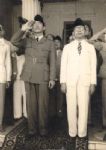





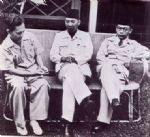

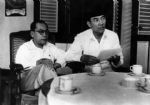
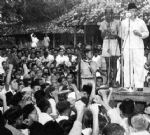


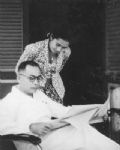
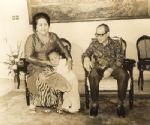
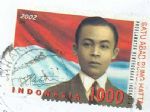
|
|
|
|
